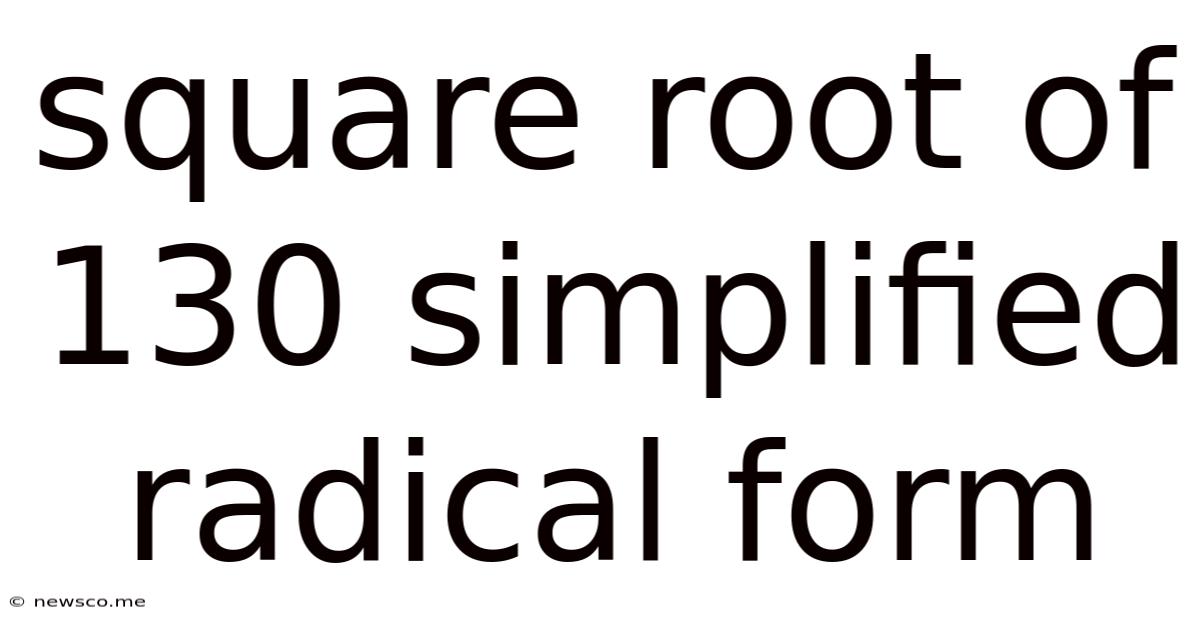Square Root Of 130 Simplified Radical Form
News Co
Apr 21, 2025 · 4 min read

Table of Contents
Simplifying the Square Root of 130: A Comprehensive Guide
The square root of 130, denoted as √130, is an irrational number. This means it cannot be expressed as a simple fraction and its decimal representation goes on forever without repeating. While we can approximate its value using a calculator (approximately 11.40175), understanding how to simplify it into its simplest radical form is crucial in algebra and other mathematical fields. This article will delve deep into the process of simplifying √130, exploring the underlying concepts and providing practical examples.
Understanding Radicals and Simplification
Before diving into the simplification of √130, let's review some fundamental concepts about radicals and simplification.
What is a Radical?
A radical, denoted by the symbol √ (a radical symbol), represents a root of a number. The number inside the radical symbol is called the radicand. The small number (index) above the radical symbol indicates the type of root. For example:
- √9 (square root of 9) = 3 because 3 x 3 = 9
- ³√8 (cube root of 8) = 2 because 2 x 2 x 2 = 8
- ⁴√16 (fourth root of 16) = 2 because 2 x 2 x 2 x 2 = 16
When no index is written, it's understood to be a square root (index of 2).
Simplifying Radicals
Simplifying a radical involves reducing the radicand to its simplest form by removing any perfect square factors. A perfect square is a number that is the square of an integer (e.g., 4, 9, 16, 25, etc.). The goal is to express the radical as a product of a whole number and a radical containing only prime factors.
For example, let's simplify √12:
- Find the prime factorization of the radicand: 12 = 2 x 2 x 3 = 2² x 3
- Identify perfect square factors: 2² is a perfect square.
- Simplify: √12 = √(2² x 3) = √2² x √3 = 2√3
This means √12 simplifies to 2√3. This simplified form is more concise and easier to work with in mathematical calculations.
Simplifying the Square Root of 130
Now let's apply these concepts to simplifying √130.
-
Find the prime factorization of 130:
To find the prime factorization of 130, we can use a factor tree:
130 = 2 x 65 65 = 5 x 13
Therefore, the prime factorization of 130 is 2 x 5 x 13.
-
Identify perfect square factors:
Looking at the prime factorization (2 x 5 x 13), we see that there are no perfect square factors. None of the prime factors appear more than once.
-
Simplify:
Since there are no perfect square factors, √130 is already in its simplest radical form. We cannot simplify it further.
Why √130 Cannot Be Simplified Further
The reason √130 cannot be simplified further is because its prime factorization (2 x 5 x 13) does not contain any perfect square factors. Each prime factor appears only once. To simplify a radical, we need to find pairs of identical prime factors within the radicand. In the case of √130, no such pairs exist.
Approximating √130
Although √130 cannot be simplified, we can approximate its value using a calculator or by using estimation techniques. Knowing that 11² = 121 and 12² = 144, we can estimate that √130 is between 11 and 12, closer to 11.
Working with Simplified Radicals in Equations
Understanding how to simplify radicals is crucial when solving equations and working with expressions involving square roots. For instance, consider the equation:
x² = 130
To solve for x, we would take the square root of both sides:
√x² = ±√130
x = ±√130
In this case, even though we cannot simplify √130, the simplified form is still the most concise and useful representation of the solution.
Advanced Concepts: Radicals and Operations
Working with radicals also involves understanding how to perform various operations such as addition, subtraction, multiplication, and division. Remember that you can only add or subtract radicals that have the same radicand. For example:
2√3 + 5√3 = 7√3
However, 2√3 + 5√2 cannot be simplified further.
Multiplication and division of radicals involve multiplying or dividing the radicands and then simplifying the result.
Practical Applications of Radicals
Radicals, and therefore the understanding of simplification, are not just abstract mathematical concepts. They have numerous practical applications across various fields:
- Physics: Calculations involving distance, velocity, and acceleration often involve square roots.
- Engineering: Structural design and calculations related to forces and stresses frequently use radicals.
- Geometry: Finding the lengths of diagonals in geometric figures frequently requires working with square roots.
- Computer Graphics: Radicals are essential in algorithms for rendering and manipulating images.
Conclusion: Mastering Radical Simplification
While the square root of 130 cannot be simplified beyond its prime factored form, understanding the process of simplifying radicals is vital for success in algebra and related fields. The ability to identify perfect square factors and express radicals in their simplest form enables efficient mathematical calculations and problem-solving. Through practice and a solid understanding of the underlying concepts, you can master this essential mathematical skill. Remember that even if a radical cannot be simplified, presenting it in its prime factored form is a necessary step for efficient mathematical communication and further calculations.
Latest Posts
Related Post
Thank you for visiting our website which covers about Square Root Of 130 Simplified Radical Form . We hope the information provided has been useful to you. Feel free to contact us if you have any questions or need further assistance. See you next time and don't miss to bookmark.